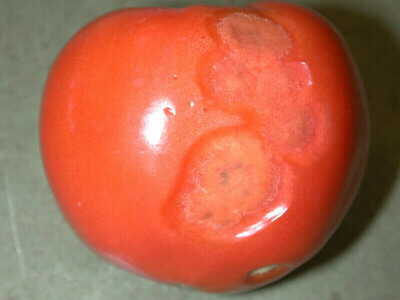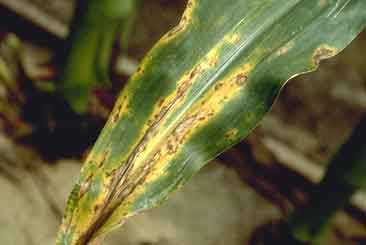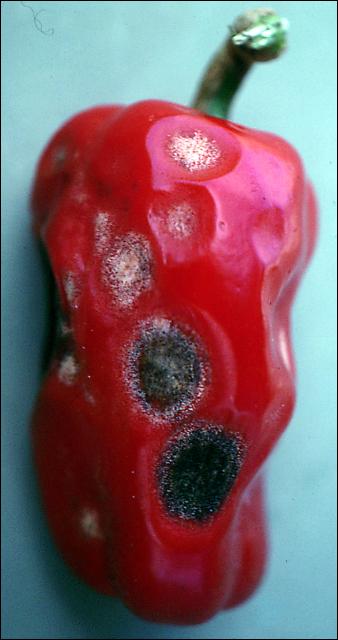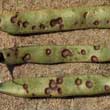Anthracnose
Anthracnose
Scientific name: Colletotrichum spp.
Causal organism: Fungus
Important species:
Host plants
Allium such as onion, garlic, leek, etc., solanaceous such as pepper, tomato, potato, etc., beans, cucurbits, lettuce, cereals, cassava, cotton, coffee, strawberry, raspberry, banana, mango, citrus, and other fruit trees.
Affected plant stages
All plant’s growth stages
Affected plant parts
Leaves, stems, petioles, pods, fruits, roots
Symptoms
Anthracnose disease attacks all plant parts at any growth stage. 症状は、葉と熟した果実で最も顕著に現れます。 最初、炭疽病は一般的に葉に小さく不規則な黄色、茶色、黒褐色、または黒色の斑点として現れる。 斑点は拡大し、合併して患部全体を覆うこともある。 感染した部分の色は、年月が経つにつれて濃くなる。 この病気はまた、葉柄や茎に穴を開け、果実や根に深刻な落葉や腐敗をもたらすことがあります。 感染した果実には、水に浸かって陥没した小さな円形の斑点があり、直径1.2cmまで大きくなることがあります。
Cotton anthracnose
感染の初期症状は、子葉の腐敗による湿害である。 感染した葉には、特にその下面にピンク褐色の斑点が現れる。 葉脈の周りの組織の広い範囲が黄色から褐色になり、やがて乾燥する。 この菌はピンク色の球根の腐敗を引き起こします。 まず、莢の上に小さく、急速に拡大する赤褐色の斑点として現れ、老化とともに黒くなる。

写真提供:
University of Minnesota
キュウリでは、葉の斑点はしばしば大きく、約10mmの大きさで縁がはっきりした薄茶からグレー色をしている。 果実の病斑は、直径20-30mmの褐色の変色として現れ、陥没し、しわが寄った暗色となり、菌類の子実体が同心円状に並んでいる。
Anthracnose of tomato
Photo courtesy of
Janna Beckerman
感染した熟したトマトの果実には、小さな、水に浸かって沈んだ、円形のスポットがあり、最大で直径 1.2 cm のサイズまで増加することができます。 この炭疽病の病斑は、他の腐敗生物を容易に引き寄せ、感染した果実を完全に腐らせます。 未熟な果実は、熟すまで症状が現れない。 根に感染したものは、黒点根腐れと呼ばれ、果実が熟し始めてから明らかになる。 根の病斑は褐色になり、子実体が点在している。 感染した根の外側の層は完全に腐っています。
バナナ炭疽病
緑色の果実では、皮に約8×3cmの黒褐色から黒色の菱形の病斑がある。 病斑は陥没し、縁は青白い。 黄変した果実では、最初は褐色の斑点が現れ、後に陥没して橙色の胞子塊に覆われる。
Photo courtesy of
University of Minnesota
Anthracnose on beans appears on leaves at all the growth stages of a plant but often appear in the early reproductive stages on stems, petioles, and pods. このような状況下で、このような事態が発生することは、非常に危険である。 斑点は拡大し、合併して患部全体を覆うこともある。 感染した部分の色は、年月が経つにつれて濃くなる。

Photo courtesy of
Ohio State University
Cereal anthracnoseに感染した穀物は、葉に茶色の楕円または長楕円形のスポット(最大1.2cm)ができ、黒茶または紫がかった縁が、しばしば黄変部に囲まれています。
トウモロコシでは、まず下葉に小さく、円形から不規則な、水に浸かったような斑点が現れる。
トウモロコシでは、まず下葉に小さな丸い、あるいは不規則な、水に浸った斑点が現れ、その後黄色、そして赤茶色の縁取りがある茶色に変わる。 このとき、葉の斑点の周囲に黄色い帯ができることが多い。
ソルガムでは、感染した葉に直径5mm以下の楕円形の黒い病斑ができ、中心部は円形で麦わら色になり、広い縁が赤から黒紫に変わることがあります。

Photo by courtesy of the Queensland Government,
Department of Primary Industries and Fisheries
Mango anthracnoseは緑の果実に小さな茶色の斑点ができて、収穫後だけ大きくなる。 また、”li “は “li “であり、”li “は “li “である。 最終的には果実全体が腐敗し、腐敗した表面に菌類の子実体が形成される。 を?めて、? この病気は、球根の首の部分を構成する、厚みのない葉の鱗茎と下部を侵し、微細で陥没した黄色っぽい斑点として現れ、拡大し、互いに結合することがあります。
Pepper anthracnose
Photo courtesy of
University of Florida
The infected leaves and fruits have small or large lesions, or purplish or brown patches without formation of definite lesions.これは感染した葉っぱや果実に、大小の病変や、明確な病変が形成されずに、褐色の斑点が見られる。 茎や葉柄は帯状になり、花序は黄変し、枯死や萎縮を起こす。 果実は通常、成熟期に病変を生じるが、感染の後期には、あらゆる大きさの果実、場合によっては葉や茎にも病変が生じることがある。 果実が熟すにつれて、感染しやすくなる。 果実上の病斑は円形で、大きな果実では直径3cm以上に達することもある。 病変の中心部の同心円は褐色または橙色から黒色の場合がある。 初期感染は不定形の日焼け色の病斑で、感染後数日で現れることもある。
発病に有利な条件
- 感染した種子、収穫後に畑に残された感染植物の破片
- 繁殖期の湿った暖かい気候。 Plants are most susceptible during the flowering stage from bloom to post harvest
- Badly drained soil
- Wet periods of about 12 hours or more favors the occurrence of infection
- Nutritionally stressed or unhealthy crops
Prevention and control
- Proper seed and planting materials selection. Sow only diseased-free seeds
- Proper field sanitation
- Seed treatment
- Transplant only healthy seedlings
- Remove and destroy infected parts but avoid touching other plant parts, especially when these are wet
- Harvest unripe but mature fruits
- Plow under all the plant debris after harvest
- Practice crop rotation. Take notes of plants that are susceptible to anthracnose disease and rotate these with those that are resistant
- Keep area free of weeds
- Baking soda spray
- Bordeaux mix
